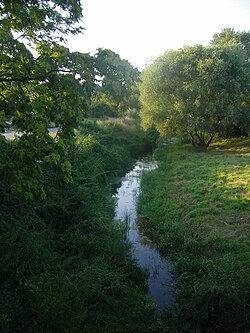Concó
| Concó | |
|---|---|
 | |
 | |
| Location | |
| Country | Hungary |
| Counties | Fejér and Komárom-Esztergom |
| Towns & villages | |
| Physical characteristics | |
| Source | Bakony range, Vértes Hills |
| Mouth | Confluence with the Danube |
• coordinates | 47°44′37″N 18°00′01″E / 47.74361°N 18.00028°E |
| Length | 49 km (30 mi) |
| Basin size | 498 km2 (192 sq mi) |
| Discharge | |
| • location | Ács, Komárom-Esztergom County |
| • average | 20.6 m3/s (730 cu ft/s) |
| Basin features | |
| Progression | Danube→ Black Sea |
| Tributaries | |
| • left | Csépi-ér, Vékony-ér |
| • right | Saliházi-árok, Kisbéri-ér, Battyáni-ér, Tóér at Nagyigmánd, Haj-patak at Kisiginánd |
| [1] | |
Concó is a river in northern Hungary, a tributary of the Danube. It rises in Fejér County and enters the Danube in Komárom-Esztergom County near the city of Komárom.[1]
Geography
The Concó rises on the northern slopes of the Bakony range of the Transdanubian Mountains and the western and northwestern slopes of the Vértes Hills. It flows basically north and slightly west. In the mountains there are warm springs due to tectonic uplift.[1] In the lower reaches the Concó is subject to flooding.[2] As of 2009, sewage, wastewater and drainage from community landfills went essentially untreated into the river.[2]
Mostly the area of the Concó Basin is wilderness in the south and farmlands in the middle and northern sections. The only significant industrial activity is in Kisbér, in the middle section. The Concó discharges into the Danube at the village of Ács.
The bedrock consists of Triassic limestones and sandstones, overlain by a thick layer of more recent alluvial sediments, predominantly sand and clay.[1]
History
The Romans had a military camp along the Concó near Ács.[3]
The Battle of Bolia in 469 between various Germanic tribes may have been fought on the banks of the Concó.[4]
Notes and references
- ^ a b c d Németh, József; et al. (2015). Jelentős Vízgazdálkodási Problémák: 1-5 Cuhai-Bakony-ér és Concó vízgyűjtőgazdálkodási tervezési alegység [Serious Water Management Problems: 1-5 The Cuha (a Balkony valley) and Concó River Basins Designated Management Subunit] (PDF). Észak-dunántúli Vízügyi Igazgatóság [Northern Transdanubian Water Directorate]. Archived (PDF) from the original on 18 June 2018.
- ^ a b "A Víz Keretirányelv hazai megvalósítása: Konzultációs Anyag: 1-5 Cuhai-Bakony-ér és Concó: konzultációs anyag vízgyűjtő-gazdálkodási tervhez" [Implementation of the Water Framework Directive in Hungary: Consultation Material: 1-5 The Cuha (a Balkony valley) and Concó: consultation material for the river basin management plan] (PDF). Vízügyi és Környezetvédelmi Központi Igazgatóság, Észak-dunántúli Környezetvédelmi és Vízügyi Igazgatóság [Directorate of Water and Environmental Protection, Northern Transdanubian Environment and Water Administration]. 2009. pp. 13–14, 17. Archived from the original (PDF) on 27 September 2013.
- ^ "Rómaiak éltek Ács határában" [Romans lived in the border of Ács] (in Hungarian). Múlt-kor. 7 May 2010. Archived from the original on 19 June 2018. Retrieved 21 August 2018.
- ^ Gračanin, Hrvoje; Škrgulja, Jana (2014). "The Ostrogoths in Late Antique Southern Pannonia". Acta Archaeologica Carpathica. 49: 165–205, page 176.
External links
- Concó vízmélység [Concó water depth] (Map). Archived from the original on 18 June 2018. Retrieved 21 August 2018. (Map showing Concó watershed)
